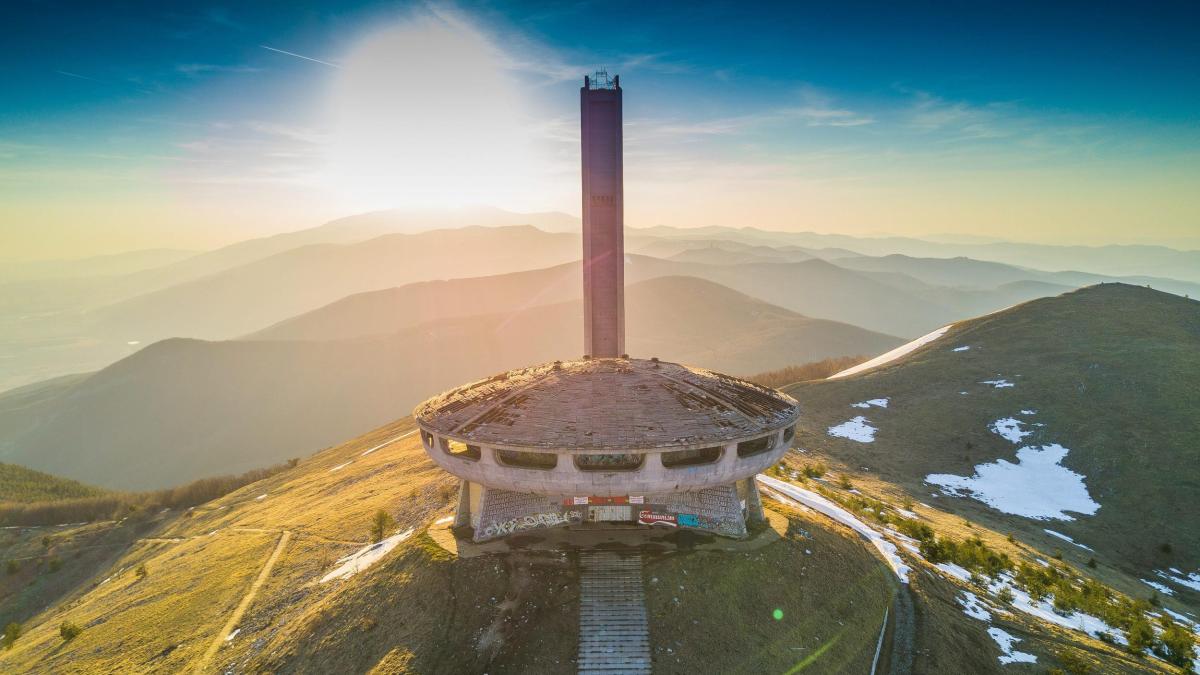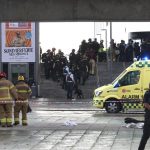SThe thing can be seen from afar. First only as a UFO-like foreign body on a wooded hilltop. Then, as you get closer, form and dimension emerge – a gigantic, indeed spaceship-like building flanked by a sculptural tower.
But the gigantic flying saucer made of concrete was not placed by aliens on this high plateau of the Chaji Dimitar mountain in central Bulgaria, which was called Buzludscha until 1942 and is still called by that in the vernacular today. It was created by Georgi Stoilov, one of the most famous architects in Bulgaria, a member of the Communist Party since 1949.
The ensemble, built in 1981, was intended to look futuristic, pointing towards the future, and symbolize the superiority of communism. In addition to propagandistic mosaics inside, the architecture itself was the means to achieve this, i.e. the expressive double form of concrete UFO and 70-meter tower. School classes were carted here until 1989, and Head of State Todor Zhivkov himself came to the opening, even though the monument is in the middle of nowhere – at the place where Bulgarian insurgents fought the Ottomans in 1868.
In the 1990s, the Buzludscha area fell into disrepair, abandoned by the state, which was no longer interested in its most bizarre monument after communism was shaken off. Today it is a ruin, which is to be saved from further decay through private commitment.
“We want to save the building and enable a new use in the long term,” says Dora Iwanowa during the helmeted climb in the central inner hall. When the young Bulgarian architect, who studied at the TU Berlin, talks about her project, you not only sense her fascination with the creative form. One can also hear that Bulgarian society still has difficulties with the architectural legacy of socialism.
A strange fascination with the Soviet era remained
A legacy that has produced a flood of communist prestige buildings like no other Eastern Bloc country of comparable size. Some of these relics are intact to this day, others are in an advanced state of decay. Hotels, convention centers, party headquarters – and time and again monuments.
Almost everything is made of concrete, the legacies are seldom pleasing or even cheerfully designed, almost always oversized and today radically outdated. Communism was peacefully abolished after reunification, Bulgaria joined NATO and the EU, and for a while even the last tsar, who returned from exile, ruled as Republican prime minister.
The monuments of the communist era remain, and with them a strange fascination with the Soviet era, whose relics are now increasingly attracting visitors. The delicate brutalism revival is also evidenced by a series of new books on the subject, such as the richly illustrated “Guide to Communist Bulgaria”.
Hardly anywhere else is the ambivalence of this fascination clearer than in the most gigantic of all monuments, the colossus “1300 years of Bulgaria” above the city of Shumen in the east of the country, also visible from afar on a mountain. A 70-meter-tall, 140-meter-long monster, from which a gigantic lion looks ill-tempered into the distance.
2,400 tons of steel and 50,000 cubic meters of concrete create two merging spaces open at the top. In them, in addition to a comparatively cheerful mosaic, somber giant sculptures represent the heroes of Bulgarian history. A ten-metre-high Great Khan Asparuch stares down grimly at the little visitors. A mad-looking Tsar Boris, father of the Christianization of Bulgaria, aggressively stretches his head forward – “tensely”, as the German-language visitor brochure well-meaningly writes.
Contrasting program for vacationers in Bulgaria
The recently deceased writer Sibylle Lewitscharoff expressed herself less well-meaning about the monument in her Bulgarian satire “Apostoloff”: “What is written there is not simply ugly, it is evil… One is forced into this evil birth gap, into this cracked, knocked open , jagged skulls, in which the Bulgarian heroes of the past – no, do not lie slumbering in their cradles and slowly grow out of the stone, but storm out of the concrete, bursting and crushing the flea-little man.”
Lewitscharoff’s narrator consistently works not only on the monuments, but on everything that can spoil travel in Bulgaria, such as bad food or lousy hotels. That’s not completely wrong, but it doesn’t do justice to the country that actually exists.
Sofia is a vital Eastern European metropolis, quite comparable to Budapest or Prague. And Plovdiv, with its lovingly renovated old town, a walk-in area monument, is also worth a visit lasting several days. So if you are on the road in terms of socialist architecture, you can and should relax your visit to the rock-heavy monuments with such feel-good places again and again.
This includes the Black Sea. In addition to other political sculptures, the coastal towns of Varna and Burgas also offer pleasant sea flair and two exceptionally beautiful sea gardens where the locals stroll and look out over the sea.
Monuments provide space for protests against Russia
But world history is not far away in Varna either. Not only that many Ukrainian refugees are on the move in the city and are a reminder that a terrible war of aggression is still raging not far away. In Varna, the next concrete block is also waiting to arouse mixed feelings in the visitor.
This one is even about Russia. Because the gigantic wing sculpture (23 meters high, 46 meters wide, 110 meters above sea level) inaugurated in 1978 was raised to commemorate the Bulgarian-Soviet friendship. Four colossal Soviet soldiers look out over the Black Sea, to where Vladimir Putin is slaughtering in Ukraine. Whether they look determined and aggressive or just dull and apathetic is in the eye of the beholder.
Many Bulgarians not only project their thoughts onto the monuments, but also use paint cans and spray cans to use the concrete walls as a direct projection surface. There is hardly a monument from the Soviet era in Bulgaria today without such visible counterstatements. Be it the soldier figures in the capital Sofia, which have recently been painted in the Ukrainian national colors. Or, for example in Varna, “Stop War” graffiti and posters on the Friendship Colossus.
It is precisely these current “comments” that show that the fascination with Soviet brutalism does not mean that the Bulgarians, who have historically close ties to Russia, wish the old days back. Recent polls show the opposite: after the Russian invasion of Ukraine, Putin is more unpopular in Bulgaria than ever before.
Large-scale spray paintings are also emblazoned on the Buzludscha ruins. The building is visibly on the verge of collapse, and Dora Ivanova’s preservation project is almost five to twelve. In the meantime, the architect has been able to secure the monument in such a way that, in exceptional cases, she can enter the building with registered visitors; an international fundraiser is underway.
To date, Ivanova’s team has implemented an emergency backup of the wall mosaics and now also the large mosaic in the main hall and has drawn up a preservation plan. More than 100 experts have contributed to it over the past three years.
Ultimately, however, it is about complete renovation and continued use – as a place of memory, but also as a cultural center and event location. Or maybe as a film backdrop? In any case, the thing has science fiction potential. And an assignment with James Bond would also be conceivable. Especially since the need for post-Soviet villains and their refuges in times like these is likely to continue to be great.
Additional Information:
Buzlujah: The project can currently only be viewed from the outside. Dora Iwanowa publishes updates on her renovation approach on this website: buzludzha-project.com
Shumen: bulgariatravel.org/founders-of-the-bulgarian-state-monument/
Varna: visit.varna.bg/en/soviet_bulgarian_monument.html
The bizarre Instagram group Socialist Modernism offers tongue-in-cheek information on socialist concrete architecture from all the former Eastern Bloc countries: instagram.com/socialistmodernism/




